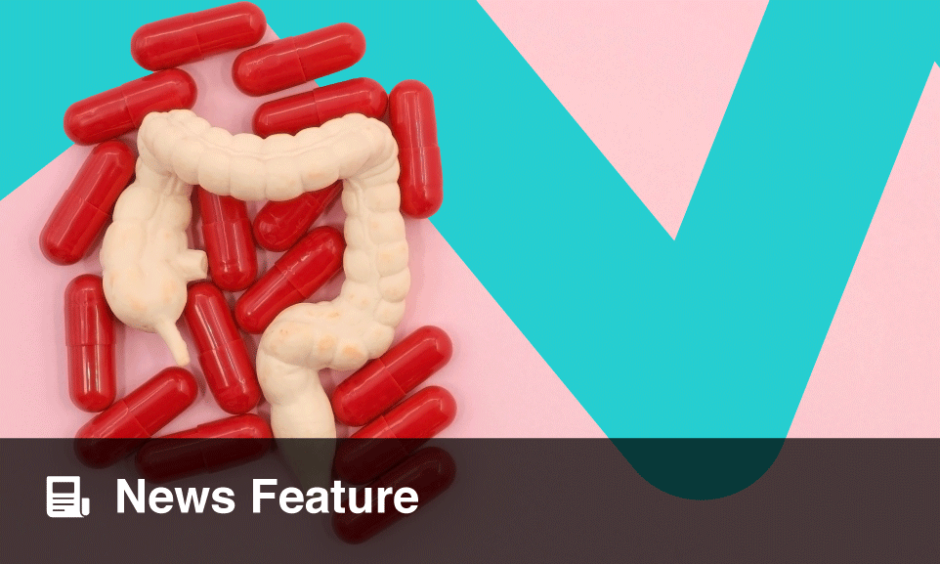Author: Hannah J. Moir
Support statement: The writing and publication of this news feature was supported by Viatris, who were not involved in the creation of this content.
![]()
The United European Gastroenterology (UEG) Week 2023 kicked off with the launch of this year’s Postgraduate Teaching programme, providing experience and practical insights relevant to daily clinical practice. The programme delivered the latest updates in the field of gastrointestinal and hepatology, based on recommendations from the European Section and Board of Gastroenterology and Hepatology (ESBGH), as known as the The Blue Book’
OPTIMISING THE USE OF ANTI-TNFS
On the 14th October 2023, during a session entitled ‘Optimise the use of drugs in IBD’, Shomron Ben-Horin, Director of the inflammatory bowel disease (IBD) service at the Gastroenterology Department, Sheba Medical Centre, Tel Aviv, Israel, presented on ‘Getting the best out of anti-TNF therapies’. Key questions addressed during the session included whether we should continue using anti-TNFs, when they are appropriate, and how best to utilise these treatments.
Given the historical context of anti-TNF therapies, with more than two decades of use, it is intriguing that we still find ourselves discussing their relevance today.
Notably, a recent network meta-analysis published in early 2023, which examined clinical trials for Crohn’s disease, identified that anti-TNFs, such as infliximab and adalimumab, continue to rank among the top five efficacious treatment options among biologics and small molecules.1 This underscores the continued efficacy of anti-TNFs for managing IBD, including Crohn’s disease and ulcerative colitis.
Ben-Horin’s session offered valuable insights and practical advice on the use of such anti-TNFs.
It is important to note that this session is based on personal opinions and experiences, and healthcare professionals should make treatment decisions in accordance with their local authority regulatory guidelines and approvals.
OPTIMISING ANTI-TNF TREATMENT IN INFLAMMATORY BOWEL DISEASE: STRATEGIES, CHALLENGES, AND FUTURE DIRECTIONS
Therapeutic Drug Monitoring
Ben-Horin identified several approaches to support the efficacy of anti-TNF treatment through therapeutic drug monitoring (TDM) and anti-drug antibody levels. However, it was noted that trials investigating the use of TDM to optimise therapy have yielded mixed results. Notably, an abstract presented at UEG Week 2023 by Manceñido Marcos et al.2 of a systematic review and meta-analysis, demonstrated that proactive TDM in patients with IBD during maintenance with anti-TNFs did not show superior efficacy. However, it did indicate a potential benefit in terms of improving the durability of anti-TNF treatment, preventing acute infusion reactions, reducing adverse events, and lowering the likelihood of surgery, at a lower economic cost.2
Inflammatory Biomarkers and Clinical Symptoms
Another management approach involves proactively using inflammatory biomarkers and clinical symptoms in combination to guide therapy management. Seminal research found that early TDM of adalimumab may serve as a valuable tool for identifying patients at risk of non-response or loss of response to the drug.3 While data from randomised control trials is lacking, for patients starting adalimumab, proactive therapy guided by clinical response, and the need for prednisone versus the need to escalate drug dosing, based on inflammatory biomarkers, resulted in achieving primary outcomes.3 Nonetheless, Ben-Horin identified that inefficacy and adverse events lead to treatment discontinuation in 20–50% of patients, and more than 50% fail to achieve mucosal healing, even when following a ‘best treat to target’ approach based on biomarkers alone.3
Looking ahead, Ben-Horin hoped that the use of a combination approach of inflammatory biomarkers and clinical symptoms may be discussed at the European Crohn’s and Colitis Organisation (ECCO) in February 2024.
Optimising Immunomodulators
Another way to optimise anti-TNF treatment involves reducing the risk of immunogenic loss-of-response. Observational studies have been investigating the identification of HLA-DQA1*05 carriers, who are at a higher risk of developing anti-TNF antibodies (infliximab and adalimumab).4 Immunomodulators have been indicated as effective in reducing this risk, regardless of the risk level, through combination immunogenicity with anti-TNFs. Despite the potential benefits of this approach, many healthcare professionals do not routinely consider human leukocyte antigen (HLA) testing, as it may not be widely available. However, exploring the option of combining HLA testing with immunomodulator use is worth considering.
In a practical context, Ben-Horin emphasised that the choice between dose escalation and the use of an immunomodulator depends on factors such as resource availability and cost, even when considering the availability of biosimilars. Ben-Horin indicated stopping once at quadruple doses, which in itself is uncommon.
When using anti-TNFs, such as methotrexate (typically at doses of 15–25 mg), as a preferred choice (although it is important to note tolerance levels can vary, and are not always tolerated), and other options, including azathioprine and thiopurines, in cases of immunogenic loss-of-response to the initial anti-TNF therapy, or in locations with limited healthcare resources, an alternative approach is the addition of an immunomodulatory agent. This approach suggests that switching to an anti-TNF in combination with an immunomodulator after losing response to the initial TNF treatment is more effective than transitioning to a monotherapy. This, Ben-Horin said, “is successful in approximately 60% of patients.” However, it is important to note that combination therapy carries a lower safety profile compared to monotherapy, and this should be carefully considered.
For patients initiating treatment with an anti-TNF in combination with an immunomodulator, discontinuation typically occurs within 6–12 months. In their clinical practice, Ben-Horin implements TDM and antibody level monitoring at every infusion to determine if a patient at an individual level is able to stop or not.
OPTIMISING DRUG DOSING FOR ENHANCED PATIENT OUTCOMES
Rather than driving drug levels indiscriminately, specific clinical populations may benefit from increased drug-level dosing. However, it is important to note that these findings stem from observational trials, rather than interventional studies. For individuals living with a higher inflammatory burden, and those with acute severe ulcerative colitis, Ben-Horin indicated: “Practitioners often start treatment with 10 mg/kg of infliximab,” as reported in a recent study by Whaley.5 When comparing drug exposure between responders and non-responders, there is no substantial difference, despite practitioners taking this approach in severe inflammatory cases.5
Visceral Fat Percentage
Additionally, predictors of high inflammatory burden and reduced remission may be linked to a higher visceral fat percentage.6 In a prospective study published in October 2023, adiposity was associated with reduced chances of response to anti-TNF infliximab, and higher infliximab was associated with deep remission in those with more visceral fat percentage.6 Consequently, it may be necessary to consider higher drug levels for patients with a higher BMI.6
Ben-Horin shed light on the importance of tailoring dosing for patients. While not all patients have the flexibility to adjust their dosages, this research presents an intriguing method of making more informed decisions using algorithm-driven dashboards, such as 6.0 mg versus 6.5 mg.
EXPLORING ALTERNATIVES FOR ENHANCING IMPROVEMENT
Anti-TNF treatments can be delivered through either subcutaneous injections or intravenous infusion, with the choice depending on the specific anti-TNF, and the patient’s unique requirements. Ben-Horin considered whether there are alternative methods for improvement, and whether switching to subcutaneous injections enhances efficacy. However, when considering recent real-world observational data published by Buisson in August 2023,7 it was observed that patients who switched to subcutaneous infliximab from an escalated dose of 10 mg/kg administered every 4–6 weeks, were less likely to benefit from switching, and exhibited a higher likelihood of relapse.7
Clinical Scenarios
In clinical scenarios, the early initiation of anti-TNF therapy has the potential to reduce the disease burden and enhance patients’ quality of life. Commencing anti-TNF treatment at an earlier stage raises questions about its benefits. Notably, a recent patient-data meta-analysis of clinical trials did not reveal a superiority in efficacy for clinical response in patients who started therapy early.8
In the case of Crohn’s disease, a cluster-randomised clinical trial presented by Jairath at UEG 2022,9 failed to establish a clear superior outcome when initiating early combination therapy with adalimumab and an immunomodulator. However, a more favourable outcome was observed in patients with elevated C-reactive protein and active inflammation when treatment was initiated early, leading to a reduced rate of complications.9
Ben-Horin emphasised the importance of individualised patient management, suggesting that an early start is most appropriate for those with genuine inflammation, and those in higher-risk populations.
Furthermore, the VEGA Phase IIa trial10 explored combination therapy involving anti-TNF and anti-IL023 in active moderate-to-severe ulcerative colitis. While this approach did not yield significant benefits across the primary outcome measures, it did show notable improvements in endoscopic findings with the combination approach.
Though anti-TNF treatments are generally well-tolerated and safe, they do carry the risk of side effects, including infections, allergic reactions, and changes in blood counts. Patients using anti-TNFs should be closely monitored for any potential side effects.
Safety concerns, especially in sensitive populations, such as individuals aged 65 years and older, deserve consideration. A retrospective cohort study involving 1,152 elderly new users of anti-TNF, compared with 480 monoclonal antibody new users with a median age of 71 years, revealed a decreased risk of infection-related hospitalisation with the monoclonal antibody.11 Nevertheless, when it comes to acute severe colitis, the choice of anti-TNF should be made, while being mindful of the safety profiles in specific populations.11
SUMMARY
Despite these considerations, anti-TNFs remain top-line effective treatments for IBD. Proactive treatment strategies, particularly for high-risk patients, involving both TDM and the targeting of inflammatory markers, hold promise. While predictive dose-tailoring through pharmacogenomics and pharmacokinetic decision tools are evolving, conclusive evidence of their effectiveness awaits interventional studies to establish a cause-and-effect relationship. Research on new ways to optimise anti-TNF therapy is ongoing, so stay tuned for future advancements in this field.
References
- Barberio B et al. Efficacy of biological therapies and small molecules in induction and maintenance of remission in luminal Crohn’s disease: systematic review and network meta-analysis. Gut. 2023;72(2):264-74.
- Manceñido Marcos N et al. PP0756 efficacy and safety of proactive drug monitoring in patients with inflammatory bowel disease during maintenance treatment with anti-TNF agents: a systematic review and meta-analysis. Dig Liver Dis. 2023:S1590-8658(23)00726-0.
- Colombel JF et al. Effect of tight control management on Crohn’s disease (CALM): a multicentre, randomised, controlled phase 3 trial. Lancet. 2017;390(10114):2779-89.
- Bergstein S, Spencer EA. DOP72 HLA-DQA1*05 associates with immunogenicity and loss of response to anti-TNF therapy in the IBD population: a meta-analysis. J Crohns Colitis. 2023;17(Suppl 1): i148-50.
- Whaley KG et al. Multicenter cohort study of infliximab pharmacokinetics and therapy response in pediatric acute severe ulcerative colitis. Clin Gastroenterol Hepatol. 2023;21(5):1338-47.
- Yarur AJ et al. Higher intra-abdominal visceral adipose tissue mass is associated with lower rates of clinical and endoscopic remission in patients with inflammatory bowel diseases initiating biologic therapy: results of the constellation study. Gastroenterology. 2023;165(4):963-75.e5.
- Buisson A et al. Effectiveness of switching from intravenous to subcutaneous infliximab in patients with inflammatory bowel diseases: the REMSWITCH study. Clin Gastroenterol Hepatol. 2023;21(9):2338-46.e3.
- Ben-Horin S et al. Efficacy of biologic drugs in short-duration versus long-duration inflammatory bowel disease: a systematic review and an individual-patient data meta-analysis of randomized controlled trials. Gastroenterology. 2022;162(2):482-94.
- Jairath V et al. A cluster-randomised controlled trial of an enhanced treatment algorithm for the management of Crohn’s disease: REACT-2. UEG J. 2022;10(Suppl 8).
- Feagan BG et al.; VEGA Study Group. Guselkumab plus golimumab combination therapy versus guselkumab or golimumab monotherapy in patients with ulcerative colitis (VEGA): a randomised, double-blind, controlled, phase 2, proof-of-concept trial. Lancet Gastroenterol Hepatol. 2023;8(4):307-20.
- Kochar B et al. Vedolizumab is associated with a lower risk of serious infections than anti-tumor necrosis factor agents in older adults. Clin Gastroenterol Hepatol. 2022;20(6):1299-305.e5.








